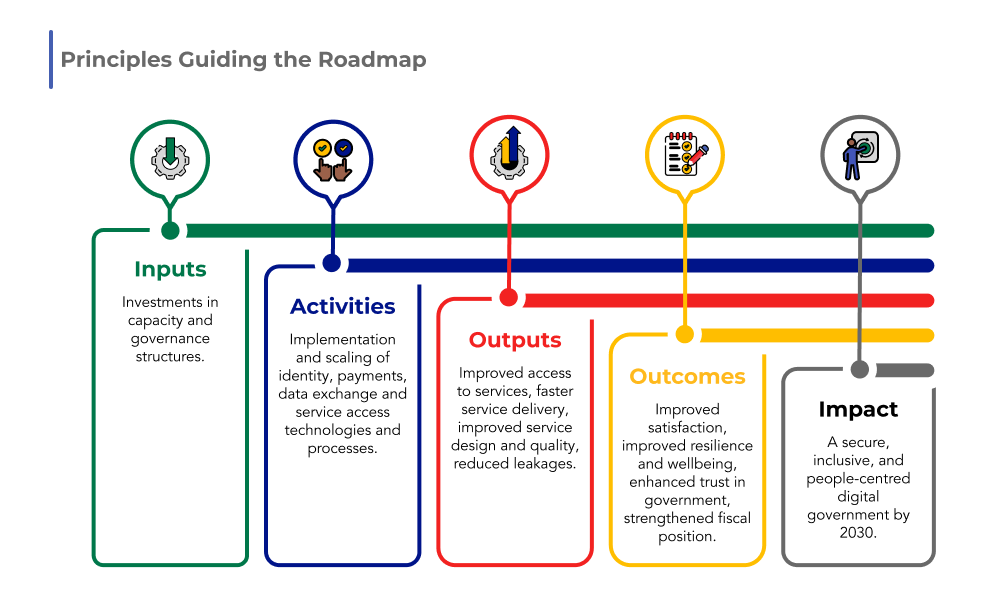Delivery Mechanisms
To implement the roadmap and ensure sustainability and transformation, four delivery mechanisms will be put in place. These mechanisms focus on coordination, capability-building, and partnerships to drive effective, inclusive and sustainable digital transformation. These mechanisms will also ensure that the changes will be delivered safely and inclusively..
Delivery Mechanism 1: Coordination Through an Effective IDWG
An Inter-Departmental Working Group (IDWG) will serve as a coordinating body. The IDWG is chaired by the Director-General of the Presidency and co-chaired by the Directors-General of the National Treasury and the DCDT. The IDWG will leverage the efforts of government departments and entities ensuring collaboration, coordination and cooperation.
Milestones
- Secure funding and resources for the IDWG Project Management Office (PMO) and Digital Service Unit (DSU) (Ongoing)
- Operationalise the IDWG and establish its PMO (Q1 2025)
- Develop a monitoring, evaluation, reporting, and learning (MERL) strategy (Q1 2025)
- Establish a local stakeholder group to engage with non-government partners (Q1 2025)
- Resource and operationalise the communication and engagement strategy (Q1 2025)
- Secure input from International Experts through an international advisory group (Q1 2025)
Explainer: The Inter-Departmental Working Group (IDWG)
The IDWG coordinates South Africa’s digital transformation agenda, working alongside the Inter-Ministerial Committee (IMC). It will engage with both domestic and international advisory groups, integrating global best practices while driving local implementation.
Delivery Mechanism 2: Building a Digital Government Capability
This mechanism will establish central leadership while empowering departments to drive transformation, with a focus on creating tools, skills and systems.
Milestones
- Establish a DSU under The Presidency (Q2 2025)
- Establish a sandbox environment to develop and test new technologies (Q2 2025)
- Align public servant performance goals with digital transformation objectives (Q4 2026)
- Establish a National Data Governance Authority (Q4 2028)
- Establish a National Cyber Security Authority (Q4 2028)
- Establish a National Enterprise Architecture Board (Q4 2028)
- Strengthen the GITOC with shared tools and resources (Ongoing)
- Roll out training and capacity building programmes for public servants (Ongoing)
- Identify and coordinate removal of legal and regulatory barriers impeding projects, with a first focus on data access in government (Ongoing)
Explainer: The Digital Service Unit (DSU)
The DSU will drive transformation and accelerate key projects, collaborating with GITOC and other entities while engaging with advisory groups for context-relevant guidance.
Delivery Mechanism 3: Unlocking Innovation Through Non-Government Ecosystems
Ongoing The PresidencyMilestones
- Introduce an internship programme (Q4 2025)
- Develop a programme to enhance the digital literacy of people who will use eGovernment services (Q4 2025) (Q4 2025)
- Establish a GovTech Centre of Excellence (Q2 2026)
- Develop a community of GovTech practitioners (Q2 2026)
- Introduce a scholarship programme (Q4 2026)
- Launch an open learning curriculum for GovTech (Q4 2026)
- Develop partnership frameworks to collaborate with non-government entities (Q4 2026) (Q4 2026)
- Share government resources and tools publicly (Ongoing)
Explainer: How the roadmap supports society-wide impact
Through skills development and the use of physical service points like Thusong Service Centres, the roadmap aims to ensure inclusive transformation and strengthen digital literacy.
Delivery Mechanism 4: Cross-Cutting Enablers
These enablers will ensure common standards, transparency, and reusable technologies, all coordinated by the DSU and relevant departments.
Key Enablers
- Delivery Mechanisms (Q4 2025)
- Delivery Mechanisms (Q4 2025)
- Establish a catalogue to enhance transparency and improve insight of:
- Delivery Mechanisms
- Delivery Mechanisms
- Delivery Mechanisms
- Delivery Mechanisms
- Delivery Mechanisms
- Develop norms and standards including but not limited to:
- Data Standards and Data Dictionary
- API Standards
- Develop and implement a user-friendly, interactive and modern service design manual and developer toolkit (Q2 2026)
- Launch a repository of reusable capabilities and developer tools for government staff with associated documentation and materials (Q4 2026)
- Establish a process for scoping emerging technology capabilities globally and their desirability by people and organisations domestically (Q4 2026)
- Develop a comprehensive Cybersecurity strategy that protects all users accessing digital government products/services (Q4 2027)
- Begin a rolling system rationalisation programme (Q4 2027)
Sustainability and Funding
The DPI approach will deliver cost savings and improved service efficiency. Initial funding will come from multiple sources including the government, development partners and private sector, with long-term resourcing shifting progressively to the fiscus.
Monitoring Progress
The roadmap will be supported by a Monitoring and Evaluation framework focused on security, inclusivity and people-centred services, tracking progress at the individual, government and infrastructure levels.
Logic Pathway

Monitoring and Evaluation
Tracking will include indicators on
- People:Service access, uptake, cost and time savings, satisfaction.
- Government: Efficiency, adoption and user satisfaction.
- Infrastructure: : Collaboration, partnerships, innovation and sustainability.

MyMzansi
The MyMzansi platform is designed to engage society in the roadmap’s implementation, inviting people and organisations to contribute ideas, insights and feedback to shape the future of digital public services.
